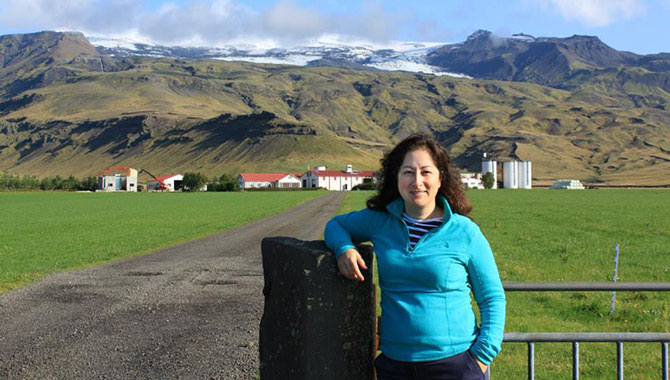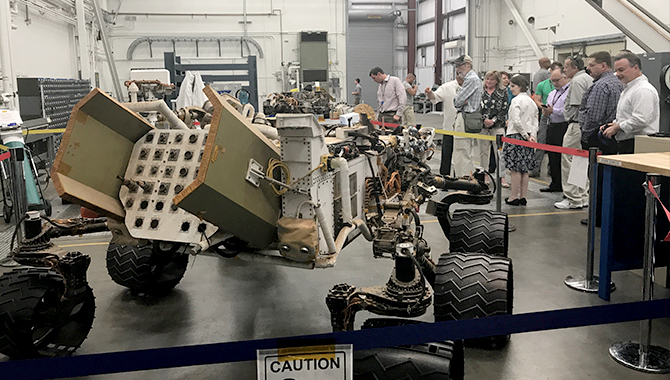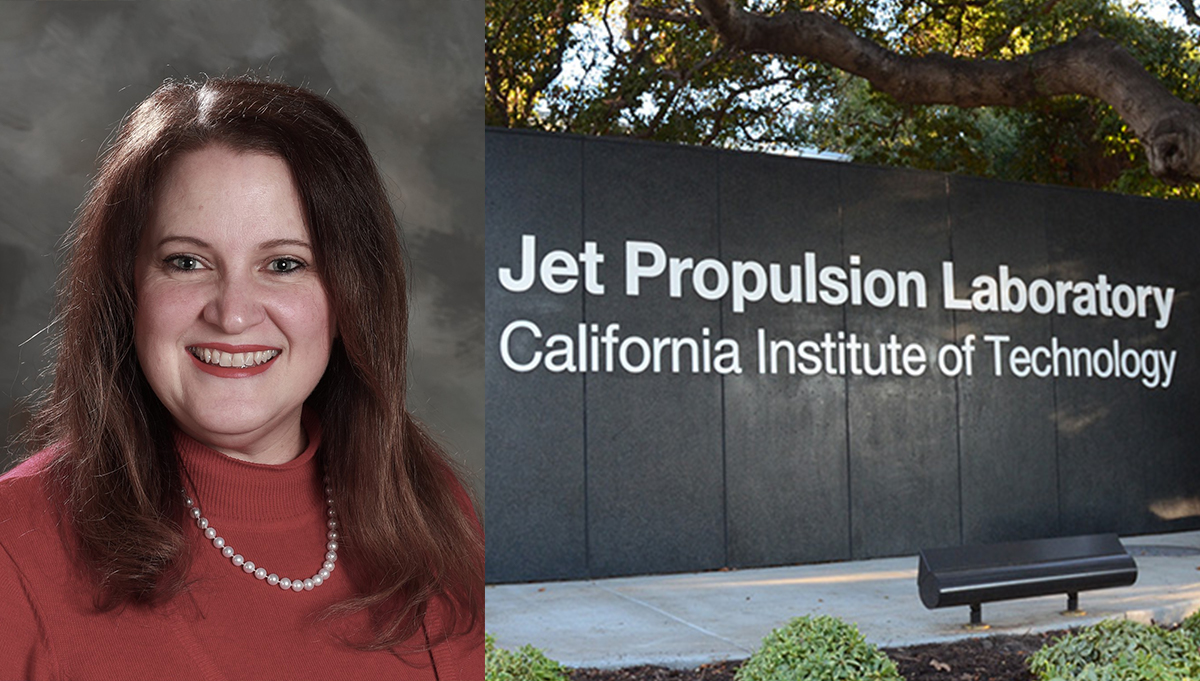
NEN Knowledge Services Lead Daria Topousis standing on a farm below the Eyjafjallajökull volcano in southern Iceland.
Photo Credit: Daria Topousis
Daria Topousis discusses knowledge sharing through the NASA Engineering Network.
Disclaimer: This material is being kept online for historical purposes. Though accurate at the time of publication, it is no longer being updated. The page may contain outdated information or broken links. Current Knowledge Community Corner articles are available here.
Daria Topousis is the NASA Engineering Network (NEN) Project Manager and Knowledge Services Lead. NEN is a collaborative system that includes strategic communities of practice, federated search, NASA’s official lessons learned, expertise locators, and other resources for NASA engineers. Topousis has more than 20 years’ experience working on collaborative tools and information systems at NASA’s Jet Propulsion Laboratory (JPL), and has extensive expertise in managing communities of practice.
What are your thoughts about the importance of communities of practice?
Communities of practice are really critical to NEN and to knowledge sharing and knowledge growth in the engineering discipline. In the early days of NEN the communities were just another element that was equal to search and lessons learned. As we’ve developed the communities, we have found that they have become the heart of NEN and the knowledge sharing that happens between people.
People can go into a propulsion community, for instance, and find out who are the other people working propulsion. They can find the lessons learned related to propulsion, post questions, and interact with peers and experts. On most of our pages on NEN, people can add content, post a news item, add themselves to a contact list, and participate in lots of ways. And then two pieces that we’ve added that made it even more interactive are subscriptions — so people can get weekly or monthly digests — and webcasts that we deliver in partnership with the NASA Engineering and Safety Center.
It’s been great to see the increase in activity in the communities of practice. These are thriving areas where people are interacting, and the communities are a most important part of NEN. We’re continuing to evolve them to try to think about what’s coming next for future generations, how we can dynamically generate content within our site based on search, and how we can really help people connect to each other even more.
Could you share best practices for setting up a community of practice and how to sustain it?
NEN has certain limitations because the problem we were trying to solve was knowledge sharing among people who cannot meet in person, so our only option was to create online communities. If I were starting a community at a NASA center, I would be careful not to think just about creating an online site. I would think about opportunities we might have for lunch-n-learns, networking in person, those kinds of things. You want to think about what you are trying to get out of the community and what you are trying to do for your center or your organization, and make decisions based on that.
I think you want to have a plan in place from the beginning for people to have the ability to collaborate. Some people make the mistake of just having a website — and that is not a community of practice. You want to make sure that people can engage and do harder things, and that it’s really clear to them how to do that.
In the early days, it’s important to have leaders who are passionate about communities and understand the power of communities. On NEN we chose to use NASA Technical Fellows because they were already recognized as the leader of their discipline. They’re center-agnostic and have a good perspective. As time went on we saw that success or failure depended on how engaged they were and how much they believed in the community of practice. We have some Tech Fellows who are spectacular and really buy into the community concept and do a lot of work to use them, and some less so.
We assign a facilitator as well to partner with the community and help it thrive. Early on when the culture is maybe not accustomed to using a community of practice, having a really active facilitator on telecons and in meetings can help people change their habits so they start to think, ‘Hey, can you post this on the community rather than us asking for it?’ And the facilitator can keep an ear to the ground to hear what people are looking for next.
As you’re growing the community and maintaining it over time, it’s good to look at the metrics every month and monitor page hits, the number of members and their contributions, so that you have a sense that you’re moving toward your success measures. We’ve found a lot of really great APQC (American Productivity & Quality Center) resources that helped us think about performance measurement.
You also need to think about end of life. We’ve seen several communities that have come to that end-of-life state where for whatever reason activity has died off or leadership has gone away. We don’t want to lose that content so we’re now in the process of trying to think about how to archive a community so the content is still there, but users know it’s no longer a living, breathing community of practice.
Are there any successful knowledge efforts in your organization that you’d like to highlight?
One is anomalies of interest. Anomalies at NASA are captured by project, and they are usually put in their own project repository. Some centers have a problem-reporting system, but some of them are program-focused. If you were to say, for example, “I want to understand all of the anomalies that happened on entry, descent and landing across multiple missions,” there’s no way to find that out right now. Some of those anomalies lead into a lesson learned. Someone at a center may see that there was an anomaly and say, “Hey, we learned some lessons from that. Let’s turn it into a lesson learned.” In the process of that, they really generalize the case to capture the broader lesson.
About two years ago, a couple of fault protection leads and two Tech Fellows from NASA came to us at the same time but not in contact with each other, and asked if we could house anomalies of broad interest across multiple missions and allow people to find out a little bit more, and also link to official anomaly databases or reports. They wanted more of the juicy technical content. And there were some cases where the anomalies just hadn’t been captured and made available. We now have several anomalies documented and we’re looking to grow that database.
How is NASA continuing to improve the agency’s federated search capabilities?
Within NEN we search about 30 different engineering repositories across the agency. We search NASA Procedural Requirements, problem and failure reporting systems, technical reports from STI, shuttle and other content from Johnson Space Center, and all our rich NEN content. We target engineering content and take steps to ensure we don’t access everything under the sun. When you come to NEN, we want you to find technical content. We don’t want you to find cafeteria menus or recreational clubs or other things that are just not relevant to engineering. We really focus on engineering data.
In the past few years we’ve partnered with Johnson Space Center, which runs the agency search, to move to a more flexible system, which is Solr search. We also add a taxonomy classification on top of that so that as people execute a search, they can filter by topics or center or year or lots of other things. I think that’s all been going well, and what we are planning next is to improve the taxonomy and look into putting a graph database underneath our search so that we can start automatically connecting pieces of content. Then you could say, ‘Hey, this topic or this paper that you’re looking at has more terms than that one,’ and you might be interested in that. So, it allows serendipitous discovery of related content you might not have known was there.
And then the other piece we’re really working through search is expertise location. Within NEN, we have a lot of information about people. We have contact lists of people. We have people who have registered for our communities. We have about 3,000 community members, many of whom have indicated areas of expertise or interest. And then we have our engineering databases where we have papers people have written and presentations they’ve given, and so we’re starting an effort this year to start to map that together. For example, someone could come to NEN and search for the topic of attitude control. They might find papers and lessons learned on attitude control, but they might also find people at the agency who know about the topic. And they could reach out to them. We’re trying to leverage search and do some simple things to enable people to find peers and experts.
Are you observing any trends or cultural shifts that affect knowledge management going forward?
There are several technology trends that are really exciting for knowledge management. I think the graph database and the use of ontology, taxonomy and data visualization are areas where there’s incredible growth and opportunity. I think even leveraging things that have been around for a while — like responsive technology where you can create a website and somebody can look at it on their tablet or phone and it looks the same as it would on their computer — is a huge leap forward. From a cultural standpoint, it’s exciting to see the millennial workforce coming in with incredible curiosity and drive to improve themselves. And we want to help by figuring out how to create knowledge services that make it easier for them to make connections between person, paper, conference, webcast or whatever it might be to get knowledge from the experienced people.
What are the biggest misunderstandings that people have about knowledge?
I think people equate knowledge with ‘let’s set up some IT tools to solve that.’ And I don’t think IT necessarily has to always be involved in a knowledge exchange. You can certainly have some knowledge programs where you’re partnering people in mentoring programs or having lunch-n-learns or story sessions where people are just sharing some of their experiences and having Q&A forums.
And then I think that there’s a sense that only certain people should be focusing on knowledge sharing, whereas I think it’s really every NASA employee’s responsibility to share what they know and pass it on to others and to be thinking about people they know who have great knowledge that should be shared. And it’s not that easy. Knowledge is sometimes equated with just data. Knowledge is really a different thing and is more tacit. You have to think about what are the ways you really bring out someone’s very particular knowledge versus just getting general data about a topic. One of the things I love about NASA is the ability to collaborate. I think a successful knowledge services world is enabled by collaboration. One of the great things that has happened just over the last few years is coming together at Knowledge 2020 so we can learn from each other and leverage each other’s experiences. I think that whole collaborative and partnering spirit that NASA has really benefits us – and we should take advantage of it.
Read other interviews from NASA Chief Knowledge Officers.









